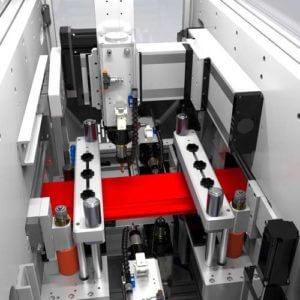Machining with high-speed drills and routers on aluminum framing; Case Study
Challenge:
Prevent deflection when machining with high-speed drills and routers on aluminum framing.
Solution:
Improve the accuracy of extrusion machining centers.
Results:
Multi-axis linear actuator system speeds the process of fabricating lineal components.
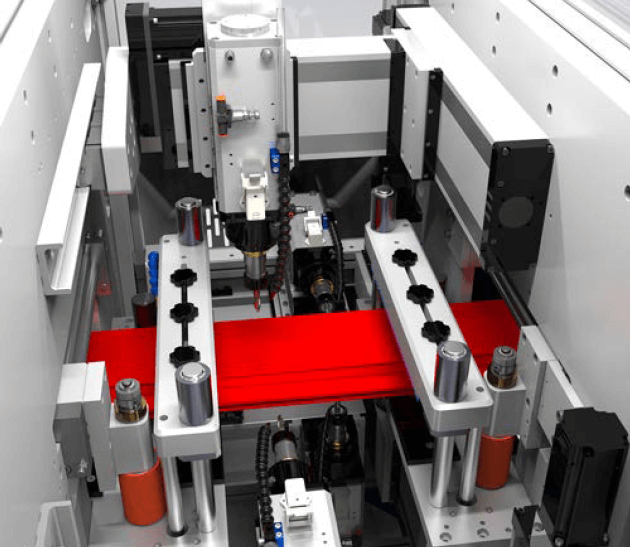
Perfect placement:
Window and door framing extrusion machining system speeds installation at construction sites
Glazing contractors must work quickly, accurately and safely at a building site to properly install window frame facings, curtain walls and storefronts in multi-story commercial buildings. Problems arise if holes drilled in extruded metal are not correctly cut to size or are misplaced. Multiplied over numerous applications, these issues can slow a project and make it go over budget. All it takes is a mis-placed quarter-inch diameter hole.
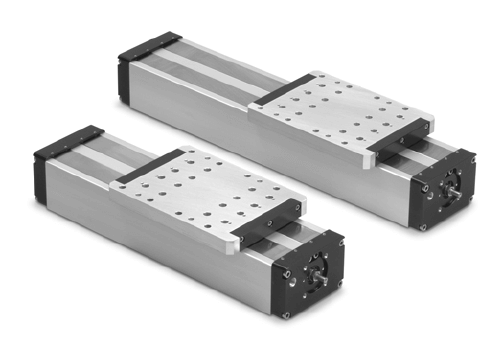
The aluminum single-body actuator design prevents deflection, and the flat carriage
design and sealed components preventmetal shavings from getting inside the unit.
Much like a CNC machine, DeMichele Group (DMG) fabri-cation machines pre-drill and cut lineal materials to spec. The newest 9-axis RhinoFab glazing machine is specifically designed to deliver the required force and pressure to drill perfectly placed holes and route intricate patterns.“We started developing our new CNC machines with some readily available actuators on the market,” said Brian Hefner, president, DMG. “But they weren’t rigid enough to properly hold our tolerances, plus they allowed for particulate to ingress, causing problems. So we committed R&D to investigate solutions to these issues, and by working closely with Tolomatic, we developed an actuator that has the sealing and rigidity we needed.”
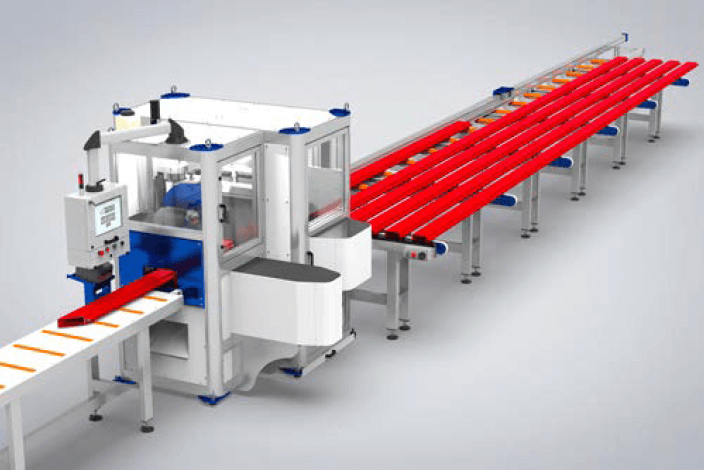
The 9-axis RhinoFab glazing machine, which pre-drills and cuts linealmaterials to spec, is designed to deliver the required force and pressure
to drill perfectly placed holes and route intricate patterns.
Since 1977, DMG, based in Chandler, Ariz., has developed software and machinery for fenestration and compli-mentary Industries. Supporting both the residential and commercial construction markets, customers include interna-tional window manufacturing firms, contract glaziers, furniture, and framing companies throughout North America.
Automated process required mechanical improvement
Framing materials, such as curtain walls (the outer, non-structural covering of a building) or storefront, usually made of extruded aluminum, are pre-drilled and cut to specified lengths for installation. The DMG software determines the precise position and number of holes or patterns required on a given length of aluminum facing. The material is automatically moved into position and the multiple 3-axis linear actuator system drills and routes the top, bottom and front. High-speed tool sets are mounted on the 3-axis actuator systems and, based on the fabrication software, create holes and shapes. A 90-degree upcut saw trims or cuts the product to the required size. Without precise control and stability in the automation process, fabri-cations could be inaccurately positioned, resulting in poor fit and finish of the completed product. Deflection is a common problem when machining with high speed drills and routers on aluminum framing. As the material moves through the machine, the cutting axis may bite, bend or wobble. If the actuator doesn’t properly hold the drill or withstand the force of the press, the drill will mis-place or incorrectly cut the hole(s). The pace of production slows until the inaccuracies are scrapped and re-machined.
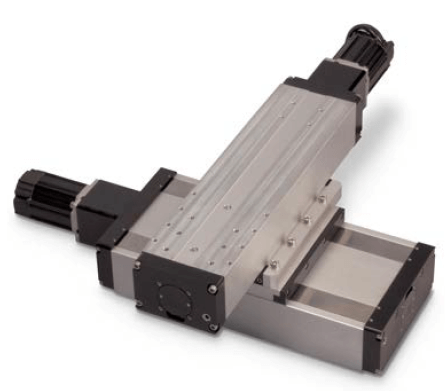
Tolomatic TRS multi-axis (XY) systemsmount carrier-to-carrier with no additional
mounting plates.
Solving the problem of instability: Tolomatic 3-axis system
The challenge was to create a multi-axis system that can push, pull and position the drill accurately. “The Twin profile Rail Stage (TRS) rodless screw-driven actuator solves two issues,” said Andy Zaske, vice president, Tolomatic. “Not just rigidity, but also cleanliness. The aluminum single-body actuator design prevents deflection and ensures a perfect cut every time.”
The actuator’s flat carriage design and sealed components are critical to prevent metal shavings from getting inside the unit. Able to carry loads up to 6.0 kN (1349 lbf), the TRS multi-axis (XY) systems mount carrier-to-carrier with no additional mounting plates.
The actuator can be used for any application requiring two or three axis configurations, such as machining centers, laser positioning, collaborative robot movement, pick-and-place and material handling.
9-axis machine accurately drills and routes every time
The RhinoFab 9-axis fabrication machine moves nine different axis points: three each on the top, bottom and front—each accommodating up to three different tool sets—to fabricate the storefront and curtainwall material. The machine can fabricate from the top and bottom at the same time. A 90-degree up-cut or down-cut saw trims the product to the required length, which then moves out of the fab center and is readied for instal-lation. The company’s Glazier Studio line of software designs, estimates and fabricates elevations for each project.
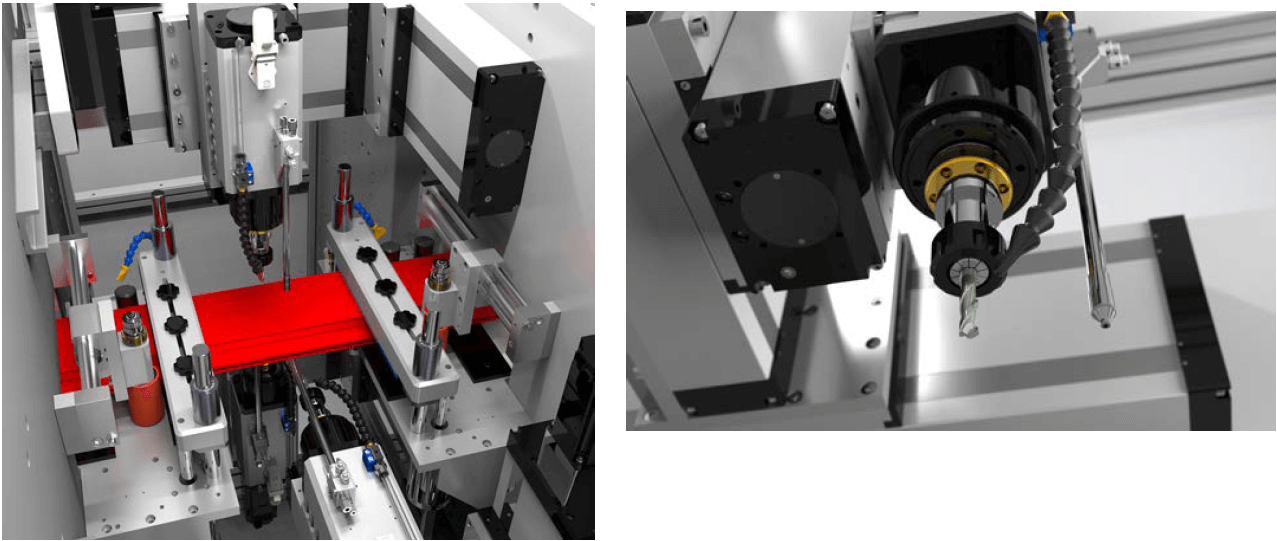 The RhinoFab 9-axis fabrication machine moves nine different axis points:three each on the top, bottom and front – each accommodating up to three
The RhinoFab 9-axis fabrication machine moves nine different axis points:three each on the top, bottom and front – each accommodating up to three
different tool sets – to fabricate the storefront and curtainwall material.The machine can fabricate from the top and bottom at the same time.
According to DeMichele President, Brian Hefner, the new machines open up the bidding process to more players. “The faster throughput gives smaller companies an economical, automated process, which allows them to optimize manual abor and also bid larger jobs. What used to be a complex and expensive process is now much more widely available.” The 9-axis machine has been so successful that DMG has continued to expand its offering of machining centers to include 11-axis and 13-axis systems and introduce another line of even more rigid and robust line of TRS actuators for their most rugged systems.
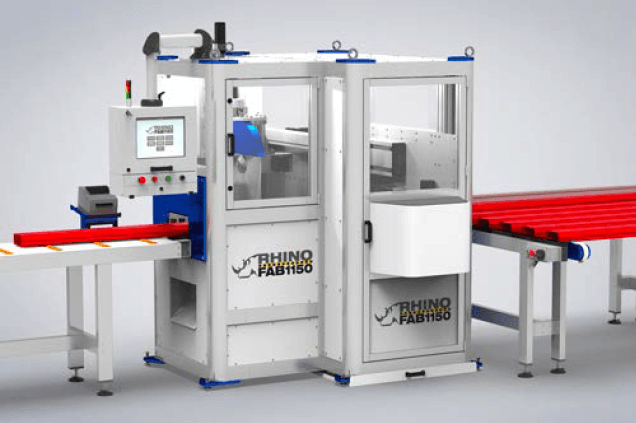
The flexible and economical fabrication centers simplify the processand reduce costs, allowing smaller window manufacturers and contract
glaziers to compete on projects and bids typically won by larger players.

